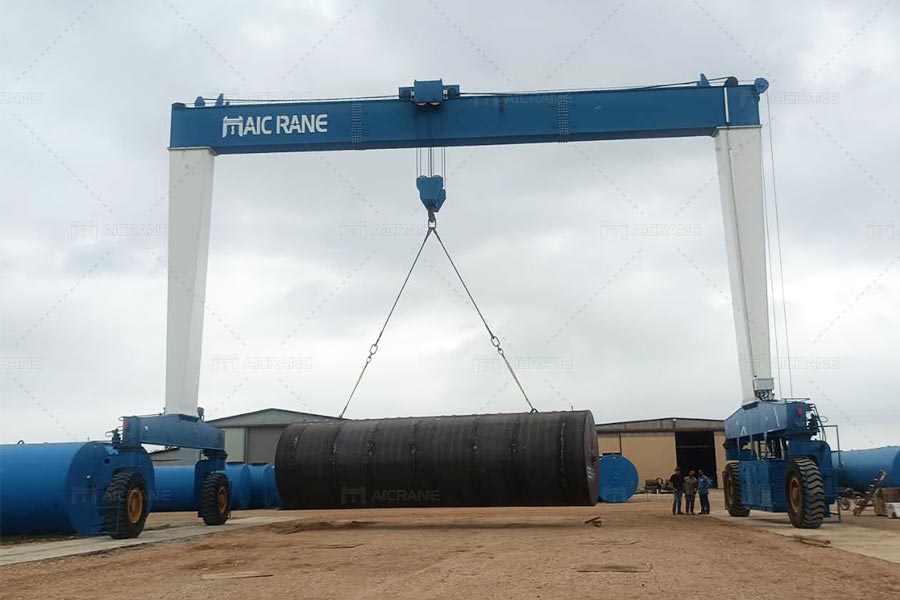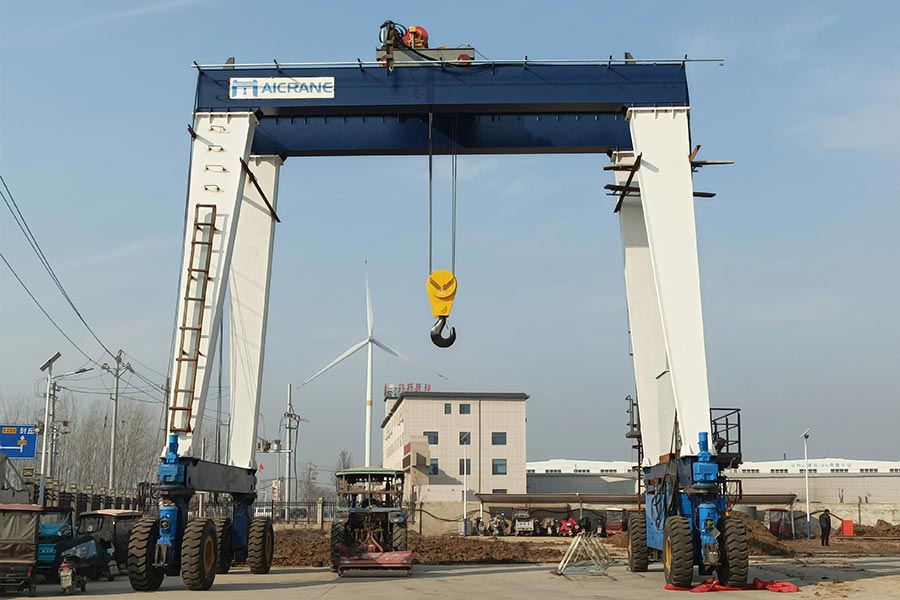Rubber Tyred Gantry (RTG) cranes are a key piece of equipment in container terminals, where their ability to transport containers efficiently and effectively plays a crucial role in the overall performance of the facility. These cranes are known for their mobility, which is largely facilitated by the sophisticated steering mechanisms that control their movement. One of the most significant factors in RTG crane maneuverability is the turning radius, which directly affects how well the crane can navigate tight spaces. The steering mechanism used in an RTG crane has a direct impact on its turning radius, and understanding this relationship is vital for optimizing crane performance and operational efficiency.

What is an RTG Crane?
Before delving into the impact of steering mechanisms on turning radius, it’s important to first understand what a rubber tyred gantry crane is and how it works. RTG cranes are typically used for stacking containers in container yards, loading and unloading containers from trucks, and moving them around the terminal. These cranes are mounted on rubber tires, allowing them to move freely across the yard without being confined to fixed rails, as is the case with rail-mounted gantry (RMG) cranes.
The RTG crane is equipped with a gantry structure that can lift containers of varying sizes and weights. The wheels, which are typically powered by electric motors or hybrid systems, allow the crane to travel along predetermined paths. The mobility of the crane is crucial for accessing different areas of the terminal, especially in situations where there is limited space to maneuver.
Steering Mechanisms in RTG Cranes
RTG cranes are equipped with various types of steering mechanisms that control the direction of their movement. These mechanisms are designed to ensure precise maneuvering of the crane within a confined container yard. The primary steering systems used in RTG cranes include:
-
Conventional Steering System: In this system, the crane’s wheels are typically steered by a hydraulic system that rotates the wheels at fixed angles. The system can be configured to provide precise control of the crane’s movement, but the turning radius may be larger compared to more advanced steering systems.
-
Steering by Independent Motors: In this configuration, each wheel of the RTG crane is powered by an independent motor. This allows for more advanced steering, including the ability to adjust the angle of each wheel individually, making it possible to achieve a tighter turning radius. The independent motor system is commonly used in modern RTG cranes due to its flexibility and increased maneuverability.
-
All-Wheel Steering: This is one of the most advanced steering systems used in RTG cranes. In this configuration, all four wheels of the gantry mobile crane can rotate, allowing the crane to make sharp turns. The system’s ability to steer all the wheels simultaneously or independently leads to significant reductions in the turning radius, allowing for enhanced maneuverability in tight spaces.
-
Crab Steering: This is a variation of all-wheel steering, where the crane can move laterally, essentially allowing it to “crab” in any direction. Crab steering provides excellent maneuverability in confined spaces, such as container terminals with narrow aisles.
-
Automated Steering: Some RTG cranes are now equipped with automated steering systems that can be controlled by a central processing unit, often integrated with the terminal’s automated logistics management system. This allows for optimized crane movement, improving both operational efficiency and the turning radius.

How Steering Mechanisms Impact the Turning Radius
The turning radius of an RTG crane refers to the minimum circular turn that the crane can make when navigating around a corner. A smaller turning radius means the crane can operate in tighter spaces, making it more effective in congested terminal environments. The type of steering mechanism directly influences this turning radius, with different systems offering varying degrees of flexibility and maneuverability.
-
Conventional Steering: The conventional steering system typically results in a larger turning radius. This is because the wheels are usually fixed at predetermined angles, meaning the crane must move along a relatively straight path before making a turn. While the conventional system is simpler and more cost-effective, it limits the crane’s ability to navigate tight spaces, making it less suitable for high-density operations where space is at a premium.
-
Independent Motor Steering: The use of independent motors for each wheel significantly enhances the crane’s turning capabilities. By allowing the wheels to rotate independently, the system can adjust the steering angle of each wheel individually. This increases the flexibility of the crane, allowing it to make sharper turns. Independent motor steering can reduce the turning radius by as much as 30% compared to conventional systems, making it ideal for operations in densely packed terminals.
-
All-Wheel Steering: All-wheel steering is particularly advantageous when it comes to reducing the turning radius. By allowing all four wheels of the gantry crane for sale to rotate, this system can achieve an extremely tight turning radius, sometimes reducing it by 50% compared to conventional systems. This makes all-wheel steering an excellent choice for RTG cranes operating in environments where maneuverability is crucial. The tight turning radius not only increases the efficiency of the crane but also enhances safety by allowing the crane to avoid obstacles and other cranes more easily.
-
Crab Steering: Crab steering, which allows the crane to move sideways, is another mechanism that contributes to a reduced turning radius. This steering mode allows the crane to make sharp, lateral movements, avoiding the need to turn around in tight spaces. Crab steering is particularly useful when the crane needs to move containers between narrow aisles or when working in highly congested terminals. While crab steering reduces the need for large turns, it requires more precise control, which can be a challenge in certain conditions.
-
Automated Steering: Automated steering systems, which are often integrated with advanced terminal management software, can optimize the turning radius by adjusting the steering angles based on real-time data. These systems can calculate the most efficient path for the crane to take, reducing the amount of space required for turning. Automated systems also offer the benefit of reducing human error, ensuring that the crane operates at peak efficiency.
Benefits of a Reduced Turning Radius
A reduced turning radius offers numerous advantages for RTG cranes, particularly in container terminals where space is limited. Some of the key benefits include:
-
Increased Maneuverability: The primary benefit of a smaller turning radius is that the crane can operate more freely in confined spaces. This allows the RTG crane to move containers more efficiently, improving throughput and reducing waiting times.
-
Improved Safety: Cranes with a smaller turning radius are less likely to collide with other equipment or obstacles. The enhanced maneuverability reduces the risk of accidents, leading to safer working conditions for operators and other personnel in the terminal.
-
Higher Efficiency: A smaller turning radius allows the crane to perform more precise movements, reducing the time needed to reposition containers. This results in faster operations and improved overall terminal efficiency.
-
Reduced Yard Congestion: RTG cranes with a reduced turning radius can navigate narrow aisles and congested areas more effectively, allowing for better use of available space in the container yard.
-
Cost Savings: Improved maneuverability can also lead to cost savings. With better control and faster movements, RTG cranes can reduce fuel consumption and wear and tear on tires and mechanical components, leading to lower operational costs over time.
Conclusion
The turning radius of an RTG crane is a critical factor in determining its overall performance and efficiency in a container terminal. The steering mechanisms used in RTG cranes play a pivotal role in defining the crane’s turning radius. Advanced steering systems, such as independent motor steering, all-wheel steering, and crab steering, offer significant improvements over conventional systems, enabling the industrial gantry crane to navigate tight spaces more effectively. By optimizing the steering mechanism and reducing the turning radius, terminal operators can enhance safety, efficiency, and maneuverability, ultimately improving the overall productivity of the terminal. As container terminals continue to grow in size and complexity, the importance of choosing the right steering mechanism for RTG cranes will only increase.